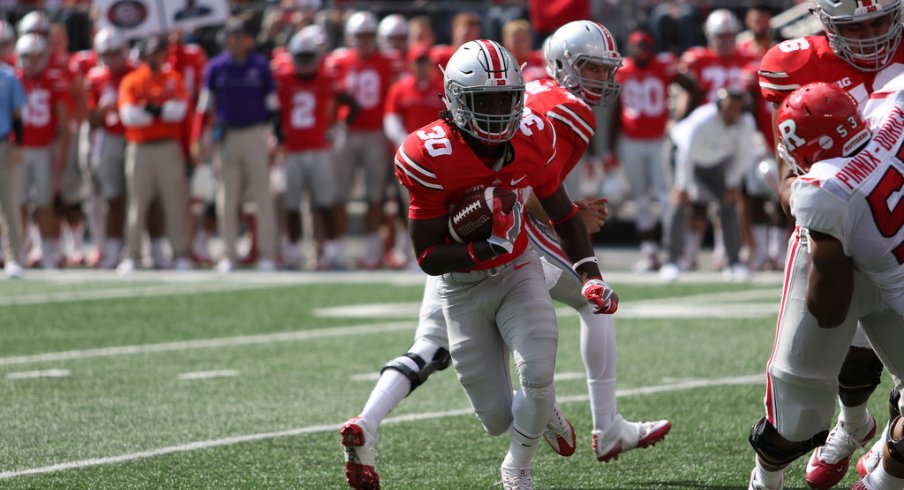Projections of Ohio State's 2017 ground game will address themes of change and consistency. The more interesting synthesis to emerge will concern who replaces the void previously filled by Curtis Samuel. The answer here may in part be a function of the small changes Wilson could implement in Ohio State's running game.
"Change" is an important component of next year's offense. The most versatile play-maker from 2016, Curtis Samuel, declared for the NFL draft and its two offensive co-coordinators, Tim Beck and Ed Warinner, left for other opportunities.
Yet much is certain for Ohio State's ground game. The offense won't abandon the run as a staple to the offense. Zone runs will still be the base around which the offense operates. Further, Ohio State's starting tailback, Mike Weber, is just a sophomore. If Kevin Wilson's past at Oklahoma and Indiana are any indication, he should be the happiest man on campus in 2017. He'll have a big season in 2017.
The bigger intrigue is less the coaching swap and more how the small differences between Wilson and Meyer will provide opportunity for new players to emerge to fill the void vacated by Curtis Samuel. Samuel's 771 yards and eight touchdowns will ostensibly be distributed among players other than Mike Weber and J.T. Barrett. Weber may have more yards as a sophomore, but Barrett may have fewer as Wilson favors treating quarterbacks as a threat to run and less a core part of the ground game itself. This feature will explore these options as a function of Wilson's philosophy.
Urban Meyer and Kevin Wilson know each other well but have never worked together. There's no past precedent on which to rely especially as both have meaningful differences. Importantly, Meyer's philosophy, starting from a disappointing Notre Dame loss to Nebraska in 2000, is to privilege the distribution of the ball to multiple play-makers. By contrast, Wilson cares more about what the defense is doing and less about who needs the ball.
This means there is a remote possibility that Mike Weber becomes the focal point of the ground game to the exclusion of other ball carriers. Consider that Tevin Coleman accounted for 2,036 of Indiana's total 3,136 rushing yards in 2014. That's a gaudy 64% of the overall rushing attack and more than 50% of the carries as no other player had more than 493 yards (D'Angelo Roberts) that year.
Demarco Murray had a comparable year when Wilson was Oklahoma's coordinator. Murray had 63% of Oklahoma's rushing yards in 2010 and 49% of the team's carries.
This is a conceivable scenario if Meyer and Wilson use other, more versatile running threats sparingly and if depth behind Mike Weber can't meaningfully supplant him. It is, however, unlikely. Those performances for Tevin Coleman and Demarco Murray look more like exceptions for Wilson than the norm. Further, Urban Meyer as head coach will still have input in the overall approach. Other running back options are likely to get meaningful touches.
Ohio State could also see a credible challenger to Mike Weber emerge in fall camp, most likely in the form of Antonio Williams. Williams was good enough to play as a true freshman in 2016, though his participation spanned a single game (Rutgers) with six carries for 28 yards. Should he be good enough to offer meaningful reprieve for Weber in 2017, Ohio State would have a two-punch combo that could make life difficult for opposing defenses. Kevin Wilson had this luxury in 2008 when Chris Brown and Demarco Murray each had over 1,000 yards rushing in what was arguably the best college football offense of all time.
More likely scenarios see Ohio State try to complement Mike Weber with someone more adroit at exploiting the edge. Weber is perfect for tight zone, the staple play of Urban Meyer's offense. He will not be ideal for any shift in emphasis toward outside zone, on which Wilson places more emphasis than Meyer.
Demario McCall is the most intriguing name to watch toward that end for multiple reasons. He is one of a few players that did not take a redshirt in 2016. He tallied 270 yards on 49 carries with three touchdowns in six games, though did not see action in Ohio State's last two games against Michigan and Clemson. He is also a fan favorite early into his career, for which a breakout sophomore season could catapult him to folklore.
McCall importantly attacks edges fast. He shows a credible "bounce" too. Outside zone play-callers privilege this feature of a running back to exploit the edge of the defense. McCall does not have a lot in his dossier for his time at Ohio State, but his touchdown against Rutgers illustrates this well.
Ohio State has another interesting option in J.K. Dobbins. The true freshman from La Grange, Texas enrolled this month to start his collegiate career early. Watch the highlight film below as a preview of what he could conceivably do his first year on campus. Dobbins' elusiveness in a tight space is apparent. His change of direction and stutter step is arguably the best I've seen covering Urban Meyer's recruiting classes since 2012.
The past few years have shown us we should be skeptical about pledges from Meyer about "we don't redshirt" even if Dobbins' abilities and his head start give him a plausible path to contribute the rushing attack in 2017.
There will be many new things about Ohio State's ground game in 2017 even if the core remains the same. Ohio State's leading rusher returns and changes to the offensive philosophy will not be wholesale. How Kevin Wilson and Urban Meyer synthesize meaningful (if small) differences between them and round out the rushing attack with other rushing options on the roster to fill the void vacated by Curtis Samuel will be an interesting development as Ohio State looks to build on a young roster toward another playoff run.


